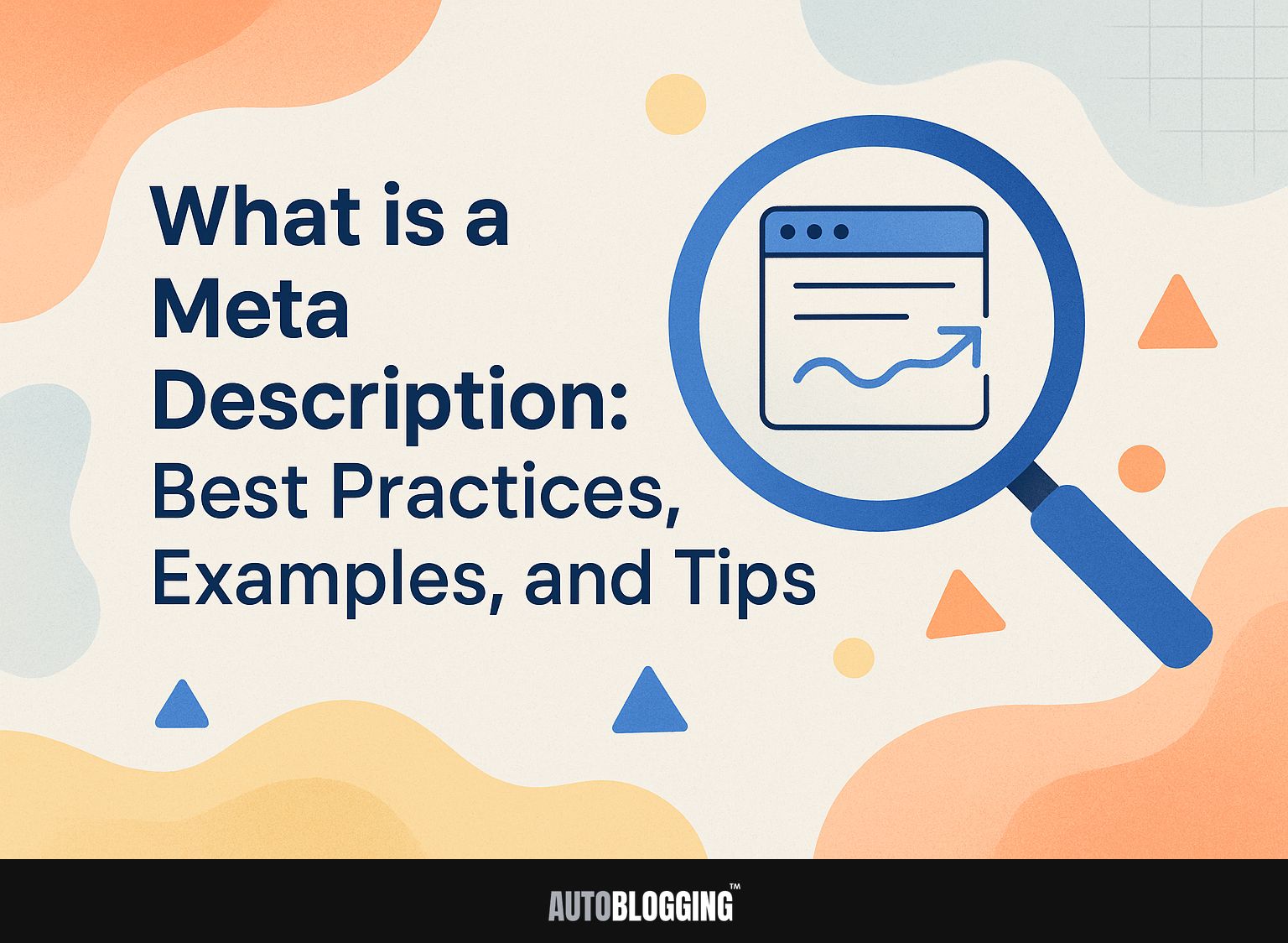
Improve your website’s visibility with well-crafted meta descriptions. These short pieces are important for SEO, affecting how often people click your links on search engines like Google. In this article, we’ll explain what a meta description is, share best practices supported by Yoast SEO, and give tips to improve your online presence. Learn how to write descriptions that grab attention and improve your website’s results!
Key Takeaways:
- A meta description is a brief summary of a webpage’s content that appears on search engine results pages (SERPs).
- Improving meta descriptions can help a website rank higher in search results and get more clicks.
- To write effective meta descriptions, keep them at the right length, include keywords, use strong call-to-actions, and update them often.
Contents
- Best Practices for Writing Meta Descriptions
- Common Mistakes to Avoid
- Examples of Effective Meta Descriptions
- Tools for Analyzing Meta Descriptions
- Testing and Improving Meta Descriptions
- Frequently Asked Questions
- 1. What is a Meta Description: Best Practices, Examples, and Tips?
- 2. Why is a well-written meta description important?
- 3. What are some best practices for writing a meta description?
- 4. Can you provide an example of a well-written meta description?
- 5. Are there any common mistakes to avoid when writing a meta description?
- 6. Any additional tips for writing an effective meta description?
1. Definition of Meta Description
A meta description is an HTML tag that provides a brief summary of a webpage’s content, typically limited to 150-160 characters.
This summary appears in search engine results below the page title, influencing click-through rates. To write effective meta descriptions, make sure they are interesting and include relevant keywords without overusing them.
For example, if you’re promoting a vegan recipe blog, a useful meta description could beFind quick and tasty vegan recipes to brighten up your meals – great for busy lives!”
By keeping your character count between 150 and 160, you maximize visibility, as search engines may truncate longer descriptions.
2. Importance in SEO
Good meta descriptions can increase click rates by 5-10%, improving a webpage’s SEO and bringing in more organic visitors.
To create effective meta descriptions, focus on clarity and relevance. Start by integrating targeted keywords naturally, as this aligns with user search intents.
Research indicates that pages with clear meta tags attract more interaction. For example, a travel blog with the title ‘Visit stunning locations in New Zealand’ instead of just ‘Travel blog’ can attract more clicks.
Keep the length between 150-160 characters to avoid truncation in search results. Tools like Yoast SEO or SEMrush can help improve your meta descriptions and check how well they work.
Best Practices for Writing Meta Descriptions
Writing clear and engaging meta descriptions can greatly improve their effectiveness and help achieve better search ranking results. To aid in crafting these descriptions, consider using our SEO Meta Description Generator for Articles. This tool provides suggestions tailored to your content, enhancing your ability to attract more clicks.
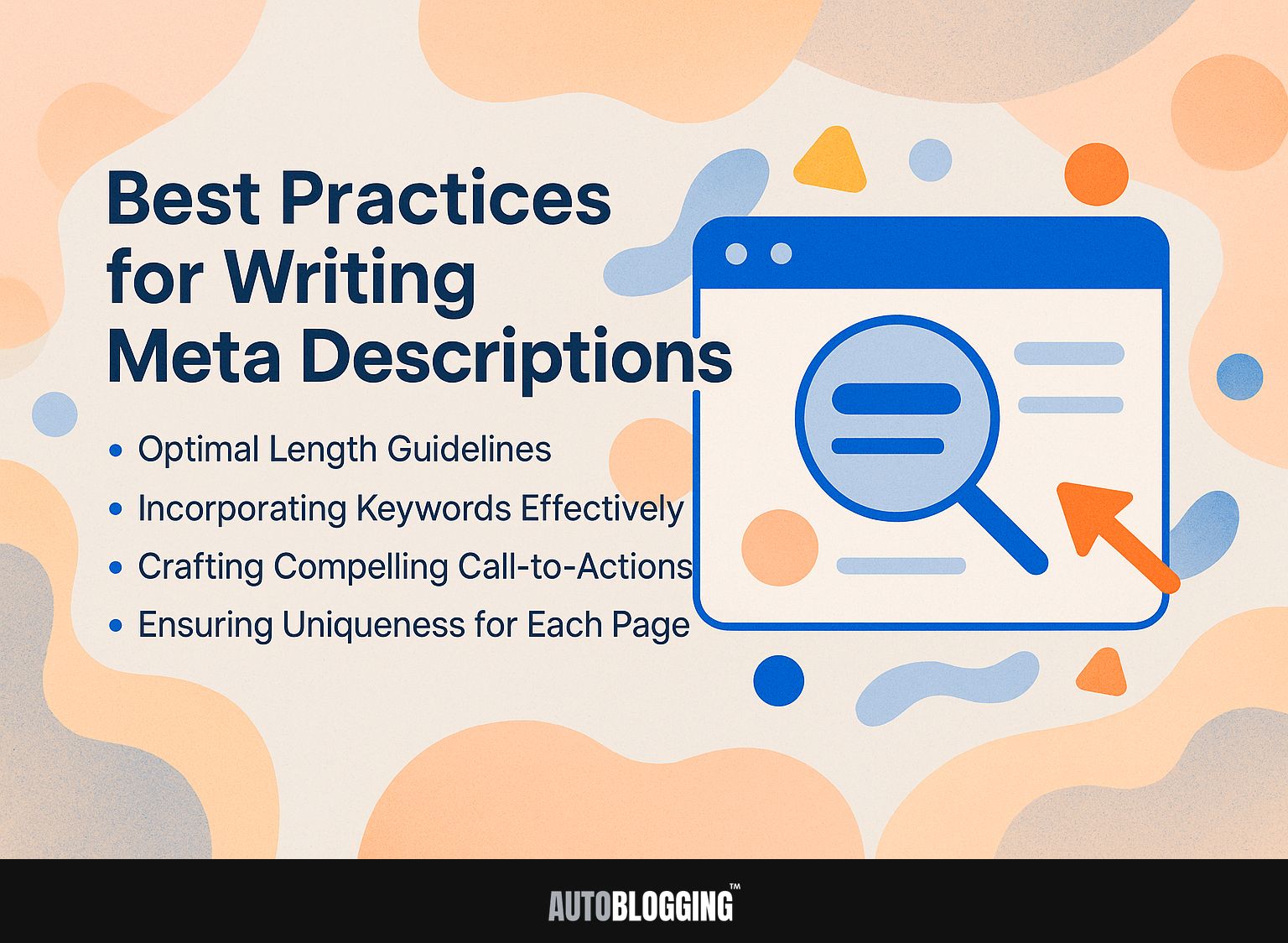
1. Optimal Length Guidelines
Keep meta descriptions between 150-160 characters so they are fully shown in search results. To keep track of character length effectively, use tools like Yoast SEO that offer immediate feedback on your meta descriptions.
Get professional content writing services that match your needs and increase your site’s visibility now! (153 characters)
Put important phrases at the beginning of the description to make it more relevant. Phrases like “expert content writers” can help drive clicks by clarifying what readers will gain from your page.
Regularly updating your meta descriptions can greatly increase click-through rates.
2. Incorporating Keywords Effectively
Use main keywords in your meta descriptions to improve their relevance and increase search engine ranking.
Start by using tools like SEMrush or Google Keyword Planner to identify relevant keywords for your target audience. After picking a main keyword, write a meta description that includes it and encourages people to click.
For example, if your main keyword is ‘organic skincare,’ an engaging meta description could be, ‘Check out our selection of organic skincare items that care for your skin using natural ingredients.’ Shop now for healthy, glowing skin!
Shoot for 150-160 characters to make sure it’s fully visible in search results.
3. Crafting Compelling Call-to-Actions
Using persuasive language in your meta description’s call-to-action can significantly increase user engagement and click-through rates.
Good call-to-action phrases are:
- ‘Learn more’
- ‘Sign up today’
- ‘Reach your potential now’
These phrases motivate users to take action by offering benefits and a sense of urgency.
For example, ‘Join us today’ builds a feeling of togetherness, while ‘Make the most of your abilities now’ connects with people’s goals. To maximize impact, tailor your CTA to match the content of your page and the expectations of your audience.
Trying out various phrases in your descriptions can show what connects best with your audience, which can lead to better results over time.
4. Ensuring Uniqueness for Each Page
Each webpage needs its own meta description to prevent issues with duplicate content and improve SEO results.
Duplicate meta descriptions can lead to significant ranking penalties from Google, as the search engine prioritizes unique content to provide a better user experience.
To keep your content original, use tools like Screaming Frog to check your website for duplicate meta tags.
Consider writing distinct meta descriptions for different page types-like product pages, blog posts, and service descriptions-to reflect their unique content and keywords. This method improves SEO and increases click-through rates by attracting user interest.
Common Mistakes to Avoid
Knowing and avoiding common mistakes in meta descriptions is important for achieving effective SEO. For an extensive analysis of this trend, our deep dive into on-page SEO techniques provides further insights and best practices to enhance your strategies.
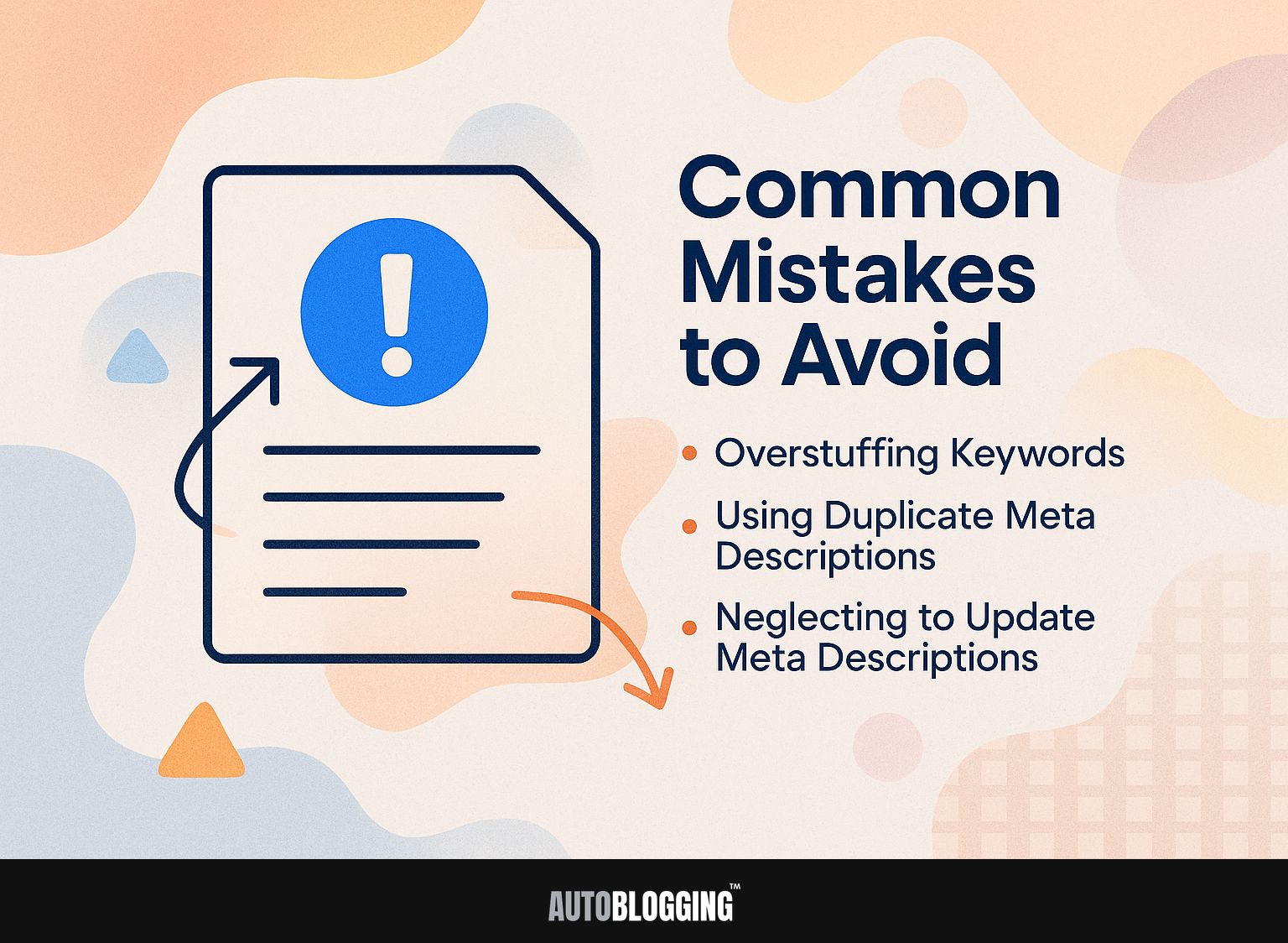
1. Overstuffing Keywords
Keyword stuffing in meta descriptions can lead to penalties from search engines, resulting in decreased visibility and traffic.
A bad example of a meta description would be, “Buy shoes, shoes for running, running shoes on sale, best running shoes for men!” This weakens the message and looks like spam.
A good choice would be, “Check out our sale on top-notch running shoes – great for beginners and experienced runners!” Make sure to have a strong call-to-action and include important keywords smoothly.
Aim for a length of 150-160 characters, striking a balance between search engine optimization and user engagement.
2. Using Duplicate Meta Descriptions
Using the same meta description across multiple pages can confuse search engines and dilute your site’s SEO effectiveness.
To improve SEO, write original meta descriptions for each page using focused keywords that suit the content.
For example, if you have multiple product pages, focus on distinct features:
- “Stylish leather wallet for men – durable and sleek”
- Canvas wallet that is environmentally friendly – ideal for daily use.
Tools like Moz or Yoast can help you check and improve these descriptions well. Try using about 150-160 characters. This length usually shows completely in search results and can lead to more clicks.
3. Neglecting to Update Meta Descriptions
Failing to update meta descriptions to reflect changes in content can lead to lower user engagement and missed SEO opportunities.
To make your meta descriptions better, review them every three months, especially after major content updates.
During these reviews, align your descriptions with current keywords and trends by using tools like Google Trends or keyword research platforms such as SEMrush.
For example, if you just published a detailed guide on social media marketing, make sure your meta description contains phrases that people are looking for. This method boosts the number of clicks on your links and keeps your SEO plan up-to-date.
Examples of Effective Meta Descriptions
Looking at good examples of meta descriptions can help you create your own that are highly effective. Worth exploring: a free tool that generates SEO meta descriptions for articles.
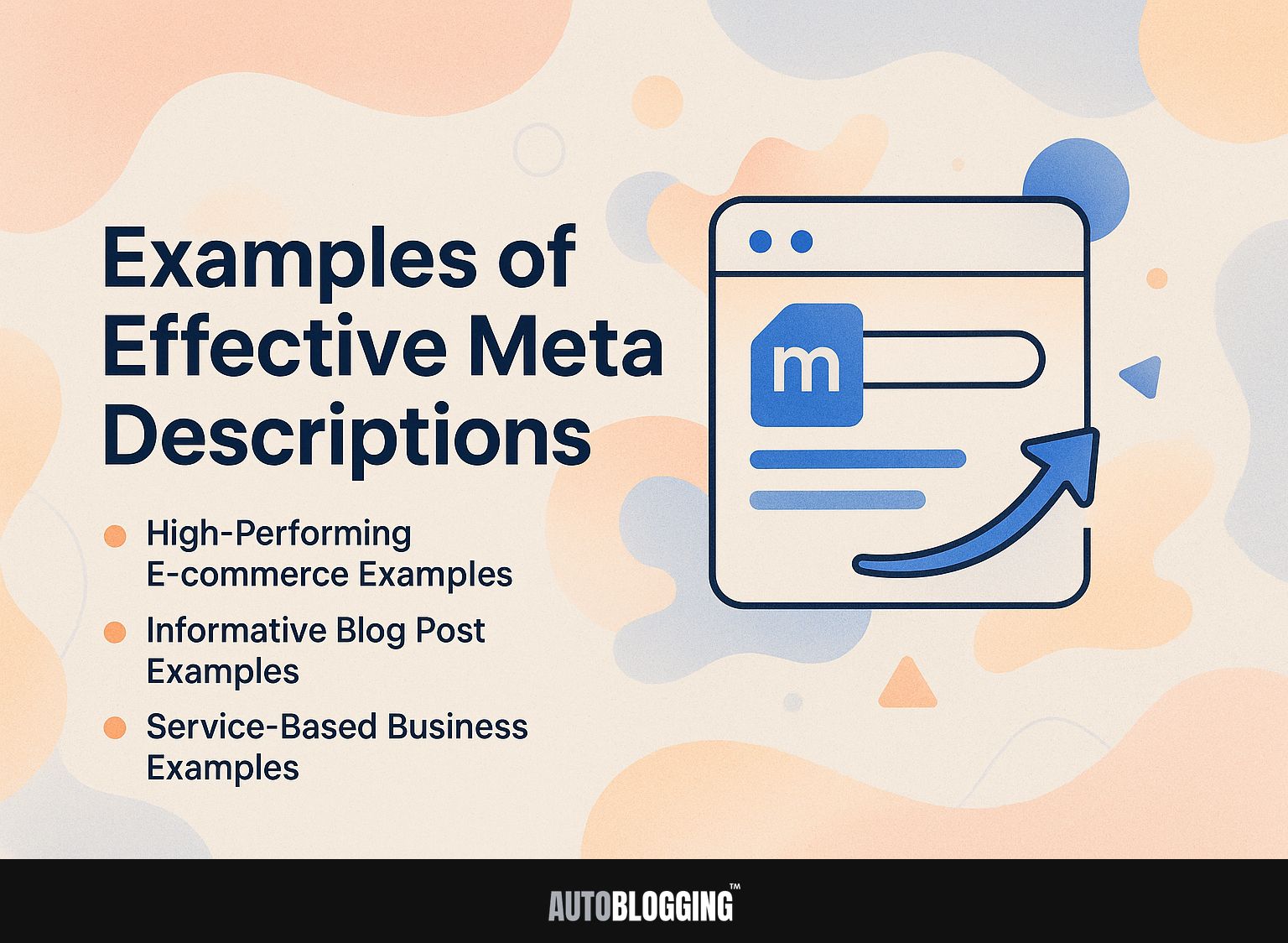
1. High-Performing E-commerce Examples
High-performing e-commerce sites often use meta descriptions that highlight product benefits and include strong calls to action.
For instance, Amazon’s meta descriptions frequently focus on unique product features and customer satisfaction, enticing shoppers to click.
Similarly, eBay uses short descriptions that highlight deals and urgency, with phrases like “limited time offer” to encourage engagement.
To improve your meta descriptions, try using tools like Yoast SEO for WordPress or SEMrush to check how well your keywords perform.
Aim for 150-160 characters, clearly outlining distinct advantages and incorporating keywords for better search visibility. Regular testing of different versions can greatly improve click-through rates.
2. Informative Blog Post Examples
Blog posts can use meta descriptions to give a brief summary and encourage readers to click the link. To make good meta descriptions, include main keywords and write a strong call to action.
Learn about the newest AI technology trends and their impact on your business. Read more to stay ahead of the curve!
Tools like Yoast SEO or All in One SEO are useful for improving meta descriptions, giving instant feedback on length and keyword use.
Try to keep it between 150-160 characters to make sure search engines show it completely. This helps you be brief but still give enough information.
3. Service-Based Business Examples
Service-based businesses gain from meta descriptions that clearly explain their services and what makes them special.
For instance, a plumbing company might use a meta description like, “Expert plumbing services at competitive rates. Available 24/7 for emergency repairs and installations. “You will be happy with our service!” This description points out their skills, readiness to help, and how happy clients are, attracting new customers.
A digital marketing agency might say, “Improve your online visibility with our custom SEO and PPC plans.” “Free first meeting!” This approach showcases customized services and easy access, effectively attracting clients in search of specific solutions.
Tools for Analyzing Meta Descriptions
Using the right tools can simplify the task of checking and improving your meta descriptions for better SEO results (our insightful guide on the importance of meta descriptions explains more).
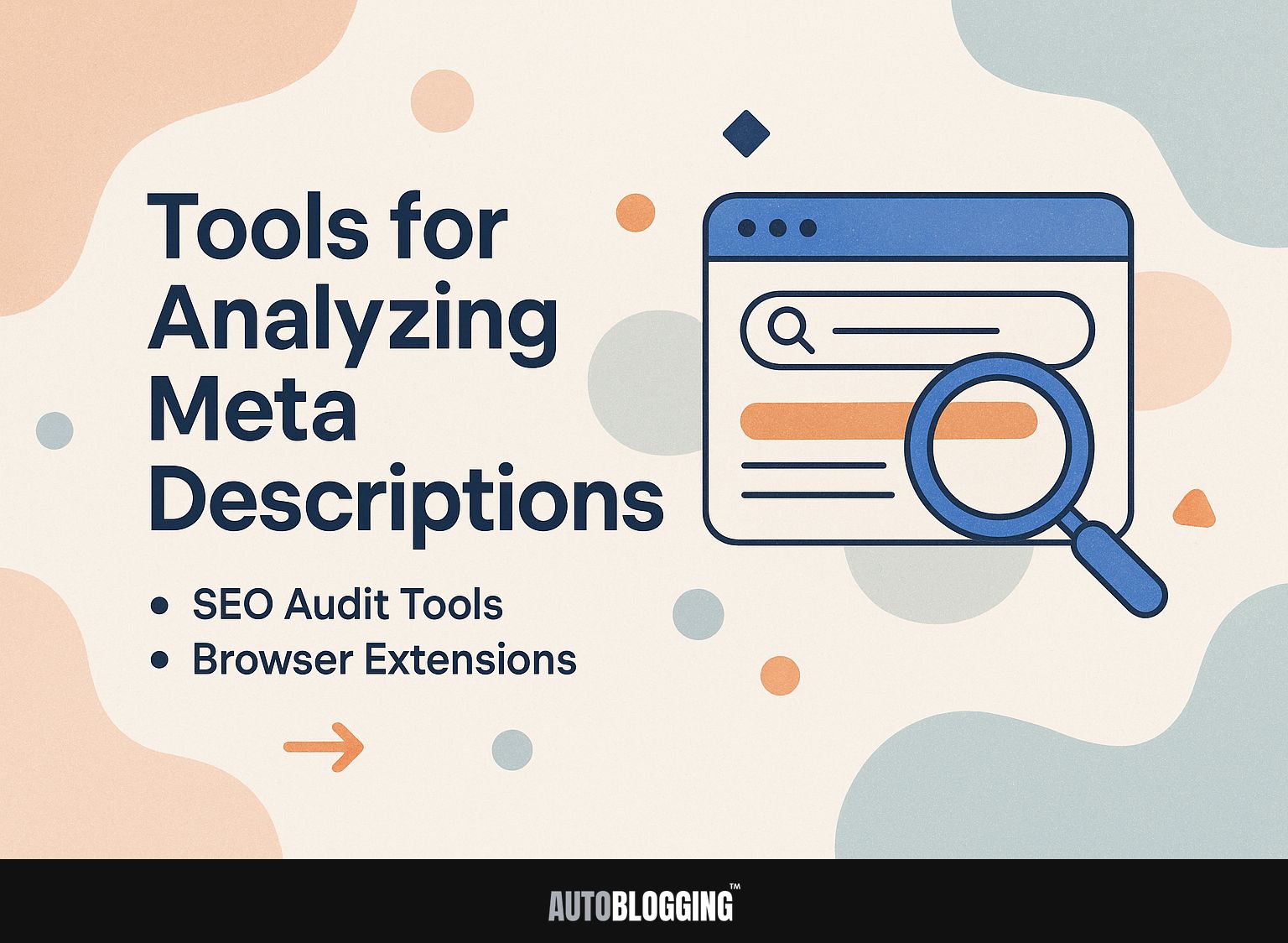
1. SEO Audit Tools
SEO audit tools like Ahrefs and Moz offer detailed features that check how well your meta descriptions are working. These tools allow you to track specific metrics, such as click-through rates (CTR), keyword usage, and length.
For example, an Ahrefs audit might reveal that a meta description over 160 characters is being truncated, suggesting a need for a rewrite. Check if the target keywords are included; if not, think about changing the description to make it more relevant.
Action items could include:
- Optimizing underperforming descriptions
- Running A/B tests to find out what your audience likes most
2. Browser Extensions
Browser extensions like SEO Meta in 1 Click give a quick look at the meta descriptions of any webpage directly from your browser. This tool shows the meta title, description, and keywords quickly, helping you make sure they are set up well for search engines.
For further analysis, consider using “Web Developer” which highlights areas of SEO improvement and provides additional tools for content evaluation.
Another great tool is “Keywords Everywhere”; this extension shows related keywords and their search volumes, helping to make meta descriptions better.
Using these tools can improve your on-page SEO and make your content better, making the process easier.
Testing and Improving Meta Descriptions
Regularly testing and improving meta descriptions is key for better SEO results and keeping high click-through rates. If you’re looking for tools to assist with this, you might find our Free SEO Meta Description Generator for Articles very useful.
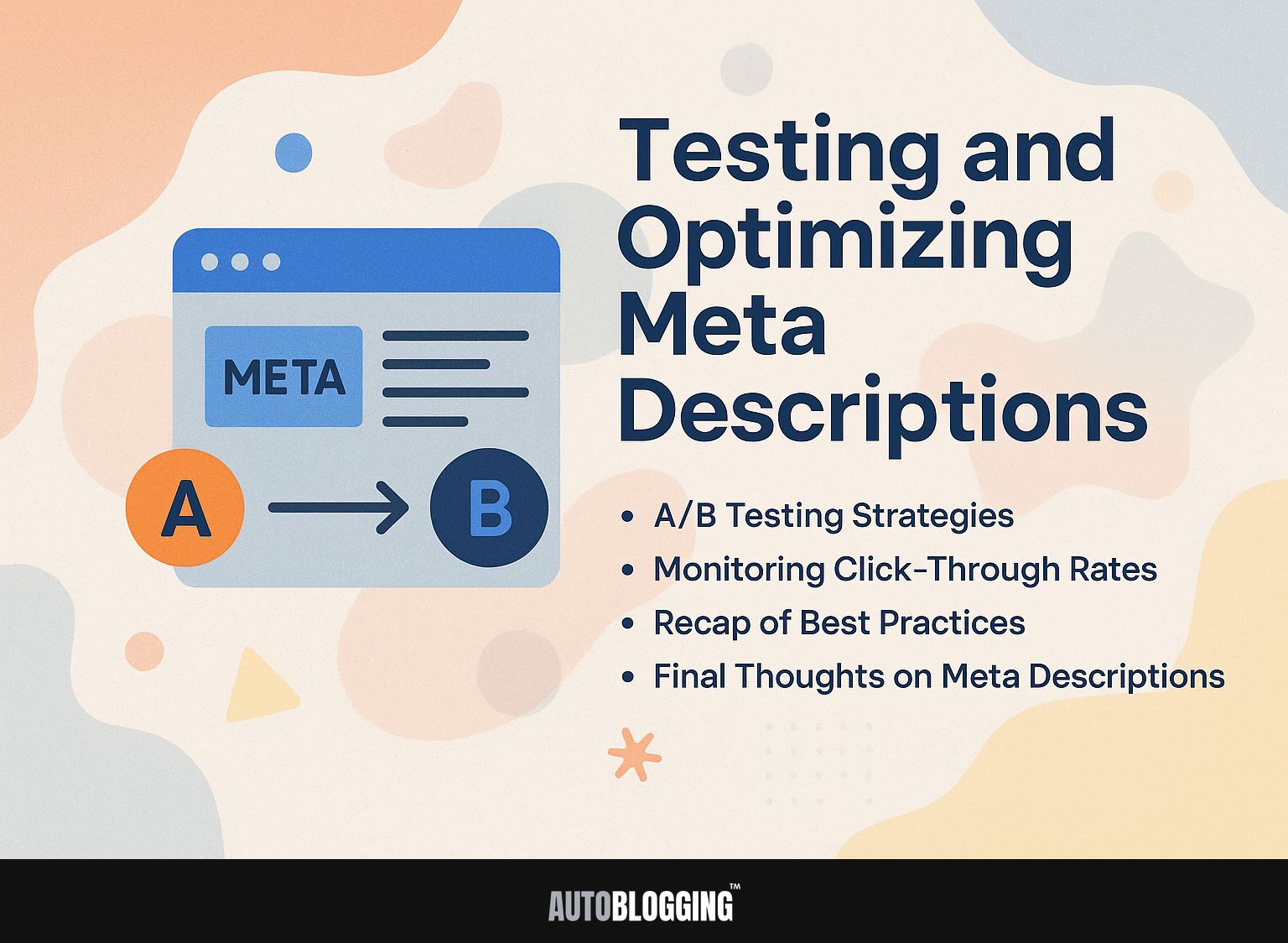
1. A/B Testing Strategies
Testing various meta descriptions with A/B testing can improve click-through rates by 10-20% over time.
Start by choosing a tool like Google Optimize to set up and run your tests without hassle.
Choose a sample page and draft two variations of the meta description, ensuring they differ significantly in length or focus. Then, set the test to run for a minimum of two weeks to gather sufficient data.
After the test concludes, use Google Analytics to analyze the performance in terms of click-through rates. Based on the results, update the successful meta description to improve engagement.
2. Monitoring Click-Through Rates
Monitoring click-through rates consistently using Google Analytics can identify which meta descriptions perform best and need adjustments.
To start tracking, go to the ‘Acquisition’ section and choose ‘Search Console’ then ‘Landing Pages.’ Here, you’ll see click-through rates, impressions, and average position.
Analyze the click-through rate (CTR) for each URL. A low CTR compared to impressions indicates a need for a more enticing meta description or title.
Use A/B testing to experiment with variations in your meta descriptions and track their performance over a month. Using this information to make practical adjustments can significantly increase the visibility and traffic to your website.
3. Recap of Best Practices
In summary, good meta descriptions should be brief, distinct, filled with important keywords, and contain a strong call to action. For optimal meta descriptions, consider these best practices:
- Make sure they are 150-160 characters long so search results don’t cut them off.
- Use main keywords early to catch attention and improve SEO.
- All descriptions must closely align with the actual page content. This helps keep user trust and lowers the chance of users leaving the page quickly.
- Implement a strong call to action like ‘Learn more’ or ‘Get started’ to encourage clicks.
- Regularly review and update your descriptions based on performance analytics to keep them relevant and engaging.
4. Final Thoughts on Meta Descriptions
Writing effective meta descriptions helps users enjoy their time on your site and makes it easier for them to locate your site in search results.
To write effective meta descriptions, concentrate on three main parts: being clear, staying relevant, and encouraging action.
For example, keep your descriptions between 150-160 characters, use specific keywords that match what people are searching for, and end with a clear call-to-action, such as “Find out more” or “Learn how to use this today!”
Consider using tools like Yoast SEO for WordPress, which provides real-time feedback on your descriptions, helping you better align with best practices.
Continuously refining your meta descriptions will keep your content fresh and improve your overall search performance.
Frequently Asked Questions
1. What is a Meta Description: Best Practices, Examples, and Tips?
A meta description is a brief summary of the content on a webpage that appears as a preview in search results. It is also known as a meta tag, and it provides important information about the page to search engines and potential visitors.
2. Why is a well-written meta description important?
Writing a clear and concise meta description can help improve a webpage’s SEO, increasing its chances of showing up in search results. It also serves as a teaser to entice users to click on the link and visit the page.
3. What are some best practices for writing a meta description?
Good tips for writing a meta description are to use relevant keywords, keep it under 160 characters, and make sure it’s different for each page. Make sure to briefly describe what the page is about and write in a way that attracts clicks.
4. Can you provide an example of a well-written meta description?
Sure, here’s an example: “Learn the best practices for writing a meta description and improve your SEO. “Find suggestions, examples, and guidance to make an engaging webpage preview.” This meta description uses important terms, is brief, and shows a clear advantage for the reader.
5. Are there any common mistakes to avoid when writing a meta description?
Yes, some common mistakes to avoid include using duplicate meta descriptions, stuffing keywords, and writing a vague or misleading preview. It’s also important to regularly check and update meta descriptions as the content on the page changes.
6. Any additional tips for writing an effective meta description?
Be sure to use active voice, include a call to action, and use proper grammar and spelling. It’s useful to check how well different meta descriptions work by tracking click-through rates and changing them if necessary.
